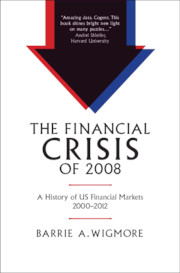Book contents
- The Financial Crisis of 2008
- Studies in Macroeconomic History
- The Financial Crisis of 2008
- Copyright page
- Dedication
- Contents
- Introduction
- 1 The Heritage of the Hi-Tech Bubble 2000–2004
- 2 The Stretch for Higher Returns 2004–2006
- 3 The Impending Storm – 2007
- 4 The Crisis – 2008
- 5 What Caused the Crisis?
- 6 The Initial Obama Administration 2009
- 7 Recovery 2010–2012
- 8 Epilogue 2012–2016
- Acknowledgments
- Charts
- Tables
- Acronyms
- Bibliography
- Index
- Studies in Macroeconomic History
- Plate Section
1 - The Heritage of the Hi-Tech Bubble 2000–2004
Published online by Cambridge University Press: 07 October 2021
- The Financial Crisis of 2008
- Studies in Macroeconomic History
- The Financial Crisis of 2008
- Copyright page
- Dedication
- Contents
- Introduction
- 1 The Heritage of the Hi-Tech Bubble 2000–2004
- 2 The Stretch for Higher Returns 2004–2006
- 3 The Impending Storm – 2007
- 4 The Crisis – 2008
- 5 What Caused the Crisis?
- 6 The Initial Obama Administration 2009
- 7 Recovery 2010–2012
- 8 Epilogue 2012–2016
- Acknowledgments
- Charts
- Tables
- Acronyms
- Bibliography
- Index
- Studies in Macroeconomic History
- Plate Section
Summary
Investors in 2000 looking back at the 1990s could have been pardoned for feeling euphoric. The S&P 500 (Chart 1.1) had risen 237% since 1992 – a compound annual rate of 16.4%. This gain followed a plethora of troubles at the end of the 1980s – the savings and loan crisis that corresponded with widespread commercial real estate problems; the collapse of the nascent junk bond market; the bankruptcy of Drexel Burnham, and the jailing of its hero, Michael Milken; and the military downsizing that followed the end of the Cold War.
- Type
- Chapter
- Information
- The Financial Crisis of 2008A History of US Financial Markets 2000–2012, pp. 9 - 33Publisher: Cambridge University PressPrint publication year: 2021

